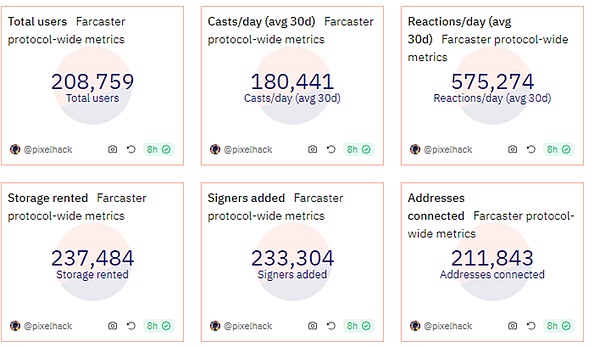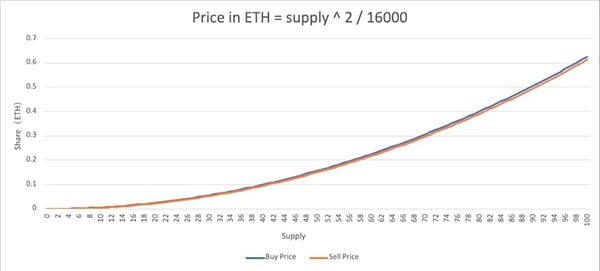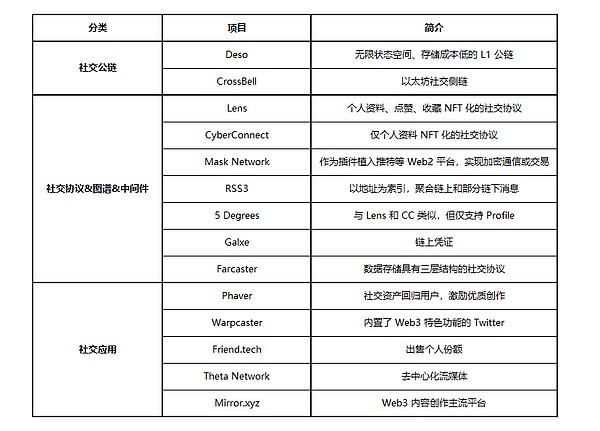Source: Gryphsis Academy
Abstract
SocialFi is currently on the fringes of the crypto market and lacks a killer app.
SocialFi has the advantages of protecting personal privacy and promoting the redistribution of traffic value.
The currently active SocialFi projects are mainly social protocols & graphs and social applications kind.
Future SocialFi projects need to lower the threshold for use and incentivize high-quality content, which is promising in the future.
1. Industry Overview
SocialFi is a collective name for projects that use blockchain technology to capture value from social networks. Since various tokens, NFTs and other tools exist in the Web3 world, super individuals in social networks can theoretically monetize their abstract influence easily.
In addition, the high degree of anonymity in the Web3 world also makes it possible to separate online public traffic and offline private life, reducing the opportunity to become an Internet opinion leader. cost.
These features make it possible for the SocialFi project to become competitive with traditional social media in theory (although we have not seen actual examples yet).
Currently, the market value of SocialFi tokens is only US$1.7 billion, accounting for about one thousandth of the total market value of cryptocurrency, which is far lower than mainstream tracks such as GameFi and NFT. , the status is relatively marginalized, and at the same time, there is no real killer or dominant application in the SocialFi track, and it is still in the early stage.
Referring to the powerful monetization ability of social traffic in the Web2 world, we believe that SocialFi still has a lot of room for development in the future.
1.1 Historical evolution
As early as around 2017, a large number of SocialFi projects, such as Steem, Huoxin, ONO, etc., but the blockchain industry technology at that time was not yet mature and the number of participating users was limited, so most of these projects have died.
In 2020, DeFi Summer attracted a large number of users and funds to the entire blockchain industry. Driven by this wave, tracks such as GameFi and SocialFi Begin to sprout. In the violent bull market at the end of 2021, another batch of SocialFi projects, such as CyberConnect, Galxe, Torum, Deso, etc., completed financing. Many of these projects are still active in the public eye, so 2021 can be regarded as the first year of SocialFi.
In 2022, Changpeng Zhao predicted in Fortune magazine that SocialFi and GameFi would become the main driving force for progress in the blockchain field in 2022. History ultimately did not develop in the direction he predicted, but some high-quality projects emerged on the SocialFi track, such as the extremely ambitious Web3 social protocol service layer Lens Protocol and the Lens-based application Phaver.
In August 2023, Friend.tech successfully emerged from the circle with a new SocialFi model with a strong Ponzi and Tugo flavor, attracting a group of Twitter influencers and even Onlyfans Bloggers came to settle in, and the 24-hour protocol fee once jumped to third place, second only to Ethereum and Lido. However, due to the crudeness of its token economics, its Keys trading volume has dropped sharply. At the same time, the project team has been slow to conduct token airdrops of points, which has gradually worn away the patience of users.

Source: Dune
1.2 Market Size
There is no doubt that the social track in a broad sense has a trillion-level market size. Even if the user group is limited to the Web3 community, the market prospects are extremely broad. However, the current Web3 community still mainly uses traditional social software such as Twitter, Telegram and even WeChat. The scale effect is particularly significant in the social track: even if better solutions emerge, the inertia formed by existing social networks will Keeping users on the original platform and migrating to a new platform will face great resistance.
Taken together, the low market value of the SocialFi track of US$1.7 billion is in sharp contrast to the broad profit margins of traditional social platforms. What we can expect The singularity of SocialFi’s future is coming.
2. Industry Graph
2.1 Social Protocol & Graph Layer
< p powered-by="xiumi.us" style="text-align: left;">Social protocols are somewhat similar to concepts such as ID cards, mobile phone numbers, and QQ numbers in the Web2 world. The use of social protocols can effectively integrate users’ social Relationships are aggregated, and at the same time, application layer projects can directly inherit the social relationships that have been fixed in the social protocol without having to rebuild them in new scenarios.
2.1.1 Lens Protocol
Lens Protocol is a very distinctive one in the protocol layer. Its core concept is to use ERC-721 to convert all concepts such as personal data, attention, and collections into NFTs. Give it financial attributes. This process is equivalent to materializing the value captured in social activities, giving its ownership completely to the creator and allowing it to circulate among different dapps. It can be said that it fully embodies the native Web3 spirit of respecting the value of data.
Lens also has good user data: it has nearly 370,000 users in the past year since its launch, and the number of daily active users is also steadily improving. Lens completed a 15 million financing in June 2023, with Web2 social giant Tencent participating in the investment.

Lens daily activity data Source: Dune
2.1.2 Farcaster
Farcaster is one of the hottest social protocols in 2023, even Vitalik himself is deeply involved in using the protocol and promoting it.
The data structure of Farcaster protocol is divided into three layers: the first layer is user identity, which is stored by blockchains such as ETH and OP; the second layer is user social interaction All kinds of data generated during the process are not uploaded to the chain, but are stored in the server network formed by Hubs nodes; the third layer is the application layer, which is developed by projects within the ecosystem. Compared with Lens, Farcaster sacrifices a certain degree of decentralization and focuses more on recreating the silky functionality of traditional social media.
Farcaster has just been opened to the public in October 2023. In just a few months, it has gained 210,000 users and achieved remarkable results, mainly due to its We will introduce the circle-breaking effect brought by the ecological project Warpcast later.

Farcaster User Data Source:: Dune

Farcaster architecture diagram Source: official document
2.1.3 CyberConnect
CyberConnect (CC) is currently One of the projects with the largest number of users on the social graph track, there are nearly 1.3 million users with profile NFT alone.
CC's core concept and vision are similar to Lens, which is to NFT user profiles and link corresponding social data to NFT. The difference is that CC does not convert all operations such as following and collecting into NFTs, which means that users do not need to pay gas fees when performing these operations, significantly reducing customer acquisition costs.
In addition, compared with Lens, which is deployed on Polygon and is subject to the Polygon user environment, CC's multi-chain deployment brings certain advantages to it.
Since 2023, the number of CC users has experienced explosive growth (of course related to its airdrop expectations). After June, User growth has plateaued.

CC new user data Source: Dune
2.2 Application layer
SocialFi application layer covers a wide range of streaming media content Platforms, share-to-earn, personal currency issuance platforms, etc. can all be included in the scope of SocialFi. At the current stage, making more down-to-earth projects and attracting more users are issues that SocialFi urgently needs to solve, so innovation at the application layer is a top priority.
2.2.1 Friend .tech
Friend.tech allows users to use ETH to purchase "shares" of KOLs who have settled on the platform. The value of this share is proportional to the square of the number of shares sold. After users purchase "shares", they can gain the right to communicate directly with KOL, and at the same time, they can profit from selling the shares. In addition, Friend.tech also distributes points to actively participating users, using potential airdrop expectations to attract user participation.
There is no doubt that Friend.tech’s current economic model is destined to be unsustainable because itcan neither retain users through long-term high-quality content output to achieve profitability. , and cannot meet the exposure needs of advertisers. However, this low-threshold, publicity-oriented way of acquiring customers is worth learning from other SocialFi projects.
If Friend.tech can learn from some Meme tokens and build an ecology and improve value capture in a timely manner after gaining traffic, then it may be able to come back to life, but for now Seems less likely.

Friend.tech share price growth diagram
2.2.2 Phaver
Phaver is a social platform based on Lens and is currently the largest application in the Lens ecosystem. His core concept is to allow users to truly own their own social assets. Users can pledge tokens on content they think is of high quality. The more people who pledge, the better the quality of the content. Both creators and users who pledge tokens can get corresponding rewards. In addition, users can accumulate on-chain reputation for themselves by completing tasks, thereby increasing their points.
However, in order to prevent a large number of robots from influxing into invalid interactions, Phaver also created an original grading system that requires users to complete email verification, purchase NFTs, or pledge governance tokens , you will be eligible to exchange points for governance tokens.
Through the above mechanism,Phaver realizes incentives for contributions to publishing high-quality content and discovering high-quality content, effectively realizing value capture.
Since its launch two years ago, Phaver has accumulated more than 120k wallet connections and has 30,000-40,000 daily active users. In addition, as a multi-chain application, Phaver will soon be connected to the Farcaster protocol and issue governance tokens. It is foreseeable that it will become a strong competitor of Warpcast.
2.2.3 Warpcast
Warpcast is the flagship project of the Farcaster ecosystem. Its interface and usage methods highly restore traditional social platforms, bringing users an extremely smooth experience, which also makes it known as the "Twitter of the Web3 world."
In addition, Warpcast also natively builds Web3-specific elements such as token issuance and NFT into the App, which greatly reduces the cost of The threshold for users to participate in the hype of on-chain tokens. Such a design has inspired a fomo craze among the user community, and has even given birth to high market value Meme tokens such as $Degen.
Currently, the main purpose of users entering Warpcast is still to dig for gold. After the short-term wealth effect dissipates, can it truly replace Twitter and become the new network of Crypto Degens? Home still remains to be seen.

$Degen token price, snapshot time: 2024/3/5
2.3 Target sorting
We briefly organize the projects in the track as follows:
< p style="text-align: center;">

3 .Industry growth drivers
3.1 Users’ growing demand for personal privacy and freedom of expression
In recent years, a large number of Weibo and Twitter users have flocked to the “decentralized social platform” Mastodon. Mastodon is not a blockchain project. The technology it uses is a federated operation of multiple servers.
Different server operators can set completely different rules (for example, some servers can post articles with thousands of words, but some require users to limit articles to 500 words) Within), very similar to different states in the United States, users are free to choose to join different servers and abide by local codes of conduct.
Strictly speaking, Mastodon is not strictly decentralized, and the server "governor" can still ban an individual's account at will (but you can still choose to join other states). Mastodon has reached one million monthly active users so far, which is unmatched by any SocialFi project, but it also shows that there is still huge room for growth in the future of truly decentralized SocialFi.
Whether it is the increasing censorship in the Chinese community or various problems on Twitter, they are making people think abouthow to protect personal privacy and privacy on social platforms. Freedom of speechThis gives tracks like SocialFi an opportunity to take advantage of. In the near future, we may have the opportunity to see projects on par with or even surpass Mastodon in the SocialFi track.
3.2 Redistribution of traffic value is SocialFi’s core competitiveness
Just like the composition of Defi In order to challenge the traditional banking industry and exchanges, SocialFi’s ultimate goal is to subvert the existing social platform’s monopoly on traffic value.
Countless wealth myths have emerged in the short video wave of the Internet today, but in the process, platforms such as ByteDance and Tencent have taken away the traffic value. For the most part, the creators and consumers involved lack effective countermeasures.
Projects such as Phaver are trying to change this profit distribution pattern so that the value of traffic can truly be captured by creators and consumers.
4. Conclusion and outlook
Compared with Web2 social platforms, SocialFi has natural advantages in terms of privacy protection and data value distribution. However, due to the high threshold for using blockchain applications, most users are stumped by just creating a wallet. .
In the future, SocialFi projects should put down their modesty and think about how to spread decentralized social networking to a larger group while applying new technologies. On the one hand, they should optimize the operation process. , reduce user learning costs and improve user experience; on the other hand, we must make good use of Web3's unique token mechanism to incentivize high-quality content and high-quality creators, in order to achieve long-term user retention and positive feedback loops.
 JinseFinance
JinseFinance
 JinseFinance
JinseFinance Wilfred
Wilfred JinseFinance
JinseFinance JinseFinance
JinseFinance JinseFinance
JinseFinance JinseFinance
JinseFinance Brian
Brian Darren
Darren Coinlive
Coinlive  Nulltx
Nulltx